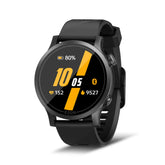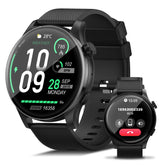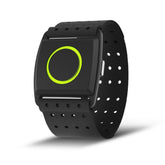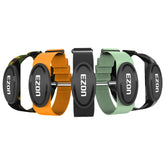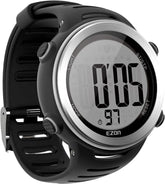Ultimate Guide to Heart Rate Training for Runners
For runners, training by heart rate is a game-changer that transforms guesswork into precision. By aligning your effort with heart rate zones, you can build endurance, boost speed, and recover smarter. In this guide, we’ll break down how to use a heart rate monitor to optimize running training, including zone calculations, workout plans, and recovery strategies tailored for runners at every level.
Why Heart Rate Training Matters for Runners
Your heart rate is a real-time gauge of effort, far more reliable than pace alone (which varies with terrain and fatigue). Benefits include:
- Prevent Overtraining: Stay within sustainable zones to avoid burnout.
- Enhance Recovery: Use heart rate data to schedule rest days when your body needs them most.
- Personalized Progress: Adapt workouts to your unique fitness level, whether you’re a beginner or aiming for a PR.
Step 1: Calculate Your Heart Rate Zones
Heart rate zones are based on your maximum heart rate (MHR), typically calculated as 220 – age, though individual variability exists. For accuracy, consider a heart rate monitor-guided max effort test (e.g., 3x1-minute all-out sprints with full recovery).
The 5 Heart Rate Zones for Runners:
- Zone 1 (50–60% MHR): Very easy, walking or gentle jogging—ideal for warm-ups/cool-downs.
- Zone 2 (60–70% MHR): Easy running, building aerobic base and fat oxidation.
- Zone 3 (70–80% MHR): Moderate, improving lactate threshold (pace you can sustain for 1–2 hours).
- Zone 4 (80–90% MHR): Hard, boosting anaerobic capacity and speed (e.g., 10K race pace).
- Zone 5 (90–100% MHR): Max effort, short sprints to improve VO2 max.
Step 2: Design Workouts for Your Goals
Goal 1: Build Aerobic Endurance (Beginner/Marathon Prep)
- Focus on Zone 2: 60–70% MHR for 40–90 minutes, 3–4 days weekly.
- Sample Workout: Steady-state run at Zone 2 pace, using a heart rate monitor to ensure you don’t creep into Zone 3.
- Benefit: Increases mitochondria density, improving oxygen utilization for longer runs.
Goal 2: Boost Speed and Threshold (Intermediate/5K–10K Runners)
- Incorporate Zone 3–4: Tempo runs (20–30 minutes at Zone 3) or threshold intervals (8x5-minute efforts at Zone 4, 2-minute recovery).
- Sample Workout: “Pyramid Intervals” – 1min (Zone 4) → 2min → 3min → 2min → 1min, with equal recovery.
- Benefit: Raises the pace you can hold before lactic acid builds up, improving race pace sustainability.
Goal 3: Maximize Speed and VO2 Max (Advanced/Competitive Runners)
- Zone 5 Sprints: 30–60 seconds at near-max effort, 2–3 minutes recovery, 6–8 reps.
- Sample Workout: 8x400m at Zone 5, focusing on quick turnover and form.
- Benefit: Enhances oxygen uptake (VO2 max), the gold standard for aerobic fitness.
Step 3: Recovery Strategies Guided by Heart Rate
1. Monitor Resting Heart Rate (RHR)
- Daily Check: Use a heart rate monitor to measure RHR upon waking. A 5–10 BPM increase signals fatigue—take a rest day or opt for Zone 1 activity.
- Long-Term Trend: A decreasing RHR over weeks indicates improved fitness.
2. Track Heart Rate Variability (HRV)
- What It Is: The time between heartbeats; higher HRV means better recovery capacity.
- How to Use It: Many heart rate monitor devices provide HRV scores. Low HRV (e.g., <50) suggests stress—prioritize sleep and gentle movement.
3. Schedule Active Recovery
- Zone 1–2 Activities: Easy jogs, yoga, or cycling to promote blood flow without strain.
- Post-Workout Protocol: Finish with 10 minutes of walking and 5 minutes of deep breathing to lower heart rate gradually.
Tools for Success: Choosing the Right Heart Rate Monitor
1. Precision Sensors
- ECG-Grade Technology: Devices like EZON’s heart rate series use advanced sensors to minimize motion interference during runs, providing reliable readings even at high intensity.
- Chest Strap Compatibility: For athletes needing clinical-grade accuracy, especially during interval training.
2. Real-Time Alerts
- Pace/Heart Rate Alerts: 震动提醒 when you drift out of your target zone, keeping you on track without constant screen-checking.
3. Data Integration
- Sync with Training Apps: Strava, TrainingPeaks, or EZON’s companion app to analyze zone distribution, track progress, and adjust plans.
Sample Weekly Heart Rate Training Plan for Runners
| Day | Activity | Heart Rate Zone | Duration | Key Focus |
|---|---|---|---|---|
| Monday | Easy Run | Zone 2 | 45–60 minutes | Form and aerobic base |
| Tuesday | Tempo Run | Zone 3 | 2x15 minutes | Lactate threshold |
| Wednesday | Strength + Active Recovery | Zone 1 | 30 minutes | Core/legs + mobility |
| Thursday | Interval Training | Zone 4–5 | 8x1-minute sprints | Speed and VO2 max |
| Friday | Rest or Yoga | N/A | N/A | Full recovery |
| Saturday | Long Run | Zone 2 | 90–120 minutes | Endurance and fueling |
| Sunday | Easy Run/Walk | Zone 1–2 | 30–45 minutes | Active recovery |
Common Pitfalls to Avoid
- Ignoring Individual Variability: Don’t rely solely on the 220–age formula. Test your MHR or use a heart rate monitor-calculated threshold for accuracy.
- Overemphasizing High Zones: Most runners benefit from 70–80% of training in Zone 2–3; save Zone 4–5 for 10–20% of workouts to avoid burnout.
- Neglecting Recovery Metrics: Use RHR and HRV to ensure you’re not training while fatigued—recovery is where fitness gains are solidified.
Elevate Your Running with EZON’s Heart Rate Monitors
- Accurate Zone Tracking: Real-time heart rate data to keep you in the right intensity for every workout.
- Durable and Lightweight: Water-resistant designs and long battery life (up to 14 days) for runs in any condition.
- Holistic Recovery Tools: Track RHR, HRV, and sleep quality to optimize rest days and prevent overtraining.
Start Training Smarter Today
Heart rate training empowers you to run with purpose, using data to guide every stride. Whether you’re chasing a faster 5K or completing your first marathon, a heart rate monitor turns guesswork into strategy, ensuring you train hard and smart.
Remember: progress isn’t about running harder—it’s about running smarter. Let your heart rate be your coach, and watch as your performance soars while staying injury-free and energized.
